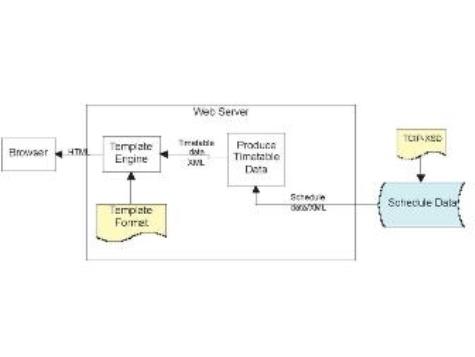|
The Dynamic Timetable Generator project developed a tool that enables transit agencies to dynamically generate timetables for customer Web access directly from “raw” schedule data. In general, transit agencies encounter problems in exchanging key data between applications. Updating schedules and timetables is of particular concern since they change frequently due to service demand, detours, and special events. Transit agencies expend significant staff time and resources in making minor changes to their Web sites or reformatting timetables due to these changes. Technologies such as Web sites, kiosks, and Internet-enabled cell phones support the rapid dissemination of timetable updates. However, tools for efficiently organizing, translating, and laying out the data to populate these media are needed.
New technologies enable the development of a tool that dynamically loads timetable data from a batch file or from a database, translates the data to a standard content and format, and then presents the information to the public in specified languages and in a variety of accessible display formats. Using new industry standards and off-the-shelf tools, the investigators built a general purpose “Dynamic Timetable Generator” tool that will automate the exchange of timetable information. An important aspect of the approach uses information technology (IT) standards to provide a solution that is applicable to a wide range of agencies. This project developed the tool based on IT standards, eXtensible Markup Language (XML), eXtensible Stylesheet Language and Transformation (XSLT), and Transit Communications Interface Profile (TCIP). This project used and supported the work by the American Public Transportation Association (APTA) on the TCIP standards. This project was the first application test of the standard. The investigators on this project coordinated closely with APTA’s Working Groups and consultants.
Tri-Met (Portland, Oregon), New York State DOT with Suffolk County Transit, and the Regional Transportation Authority (RTA) in Chicago participated in this project and tested the application.
Completed Investigation
A brief review of various types of timetable data and configurations was undertaken to ensure that the results of this project are applicable to other transit agencies, including large, medium, and small, urban, rural and suburban. The overall requirements to meet an accepted timetable model were explored, including internal data, policy, and style requirements associated with each of the represented transity agency participants. Further, the approach considered legacy and current technologies to ensure interoperability with existing investments. These requirements were incorporated into the product architecture. An input interface was developed as part of this project and supported customization of the product display.
By using the transit industry data interface standard, TCIP, which was under development by APTA and their consultants, the project team demonstrated how TCIP may be implemented in different operating environments.
Product Transfer
As part of the project, the project team and its transit agency partners tested the working product. The choice to include three transit agencies, providing data sets from four service providers, was to ensure that the concept was transferable to a range of transit agencies that offer different service types and retain various levels of technical expertise. All three transit agencies provided data and technical oversight as part of the project.
A number of the participating transit agencies plan to use the tool to manage regional timetable displays. For example, NYS DOT will include the Dynamic Timetable Generator in their Transit Schedule Data Exchange Architecture to provide timetables for transit operators in the downstate New York region. The tool was highlighted in the Federal Transit Administration report, Advanced Public Transportation Systems: The State of the Art, Update 2006 (FTA-NJ-26-7062-06-01). The participating transit agencies’ use of the project results shows a high level of interest in the new transit Dynamic Timetable Generator.
The tool is available as "open-source" software (subject to open-source licensing restrictions).
This project will provide key benefits to transit agencies as well as the public. For transit agencies, the results of this project will increase the ability to exchange schedule data and support more effective use of transit resources to deliver timely information. Also, the tool will facilitate the acquisition of automated tools by transit agencies that do not currently deploy Web-based information. For the public, the results will provide riders and potential riders with more timely, accurate, and accessible information. The tool may even serve to standardize timetable formats by using the FTA Transit Web recommended template to present schedule information to the public, which benefits riders as they travel regionally, using different service providers.
The software architecture is illustrated in Figure 1.
Product Payoff Potential
The first stage of the project (Requirements Analysis), identified the functional and interface requirements and access methods for translating and presenting the timetables. In this stage, the investigators employed a UseCase Approach to develop the concept of operations, functional requirements, as well as TCIP XML message requirements.
In the second stage (Proof of Concept) a prototype was developed in which the transit agencies supplied their data. Tools and documentation for installation, user guidance, and the software were developed.
The third stage (Production Application) included deployment of the application at Tri-Met. In this stage, a module was reviewed, improved, branded by Tri-Met, and implemented to translate data to TCIP directly from their back-office database.

Figure 1
Conceptual architecture for dynamic timetable generator.
NTIS #PB 2006-110548.
|
|